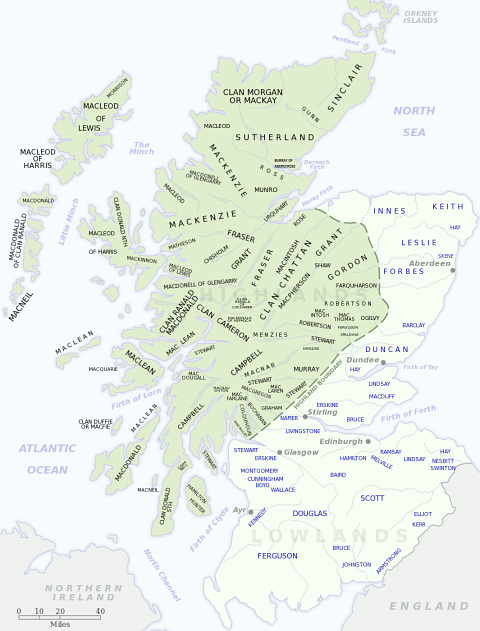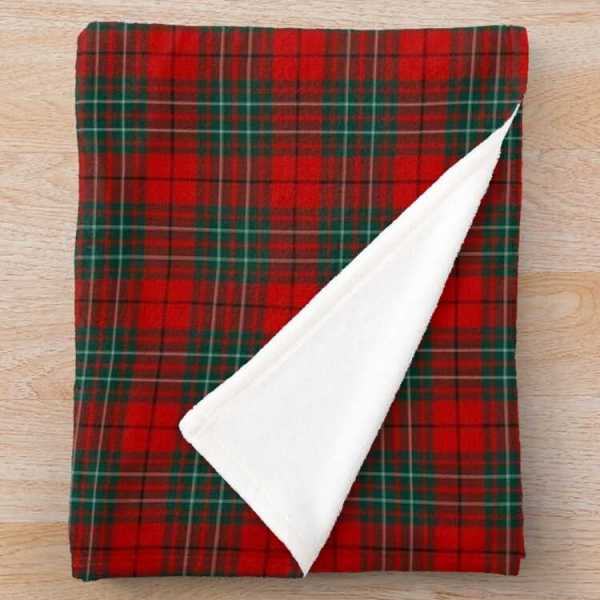
Motto: Courage
Historic Seat: Inverlochy Castle
District: Badenoch
Associated Surnames: Comine, Comyn, Cumin, MacNiven, Niven, Russell
Associated Tartans:
Early Cumming Genealogy and History:
(Excerpt from "The Scottish Clans and Their Tartans", James Grant, 1906)
The country of this once powerful clan was Badenoch, in the south-east district of Inverness-shire - wild, mountainous, now poorly inhabited, and presenting wide stretches of bleak moorland. For 250 years, from 1080 to 1330, they flourished in strength, and then began to decline.
Though some deduce them from Normandy, they would seem to have come from Northumberland; and, according to the Chronicle of Melrose1, the first one of the name who figures prominently was slain with Malcolm III at Alnwick in 1093, leaving two sons, John and William. From John all the Cumins in Scotland are said to be descended. In 1142 William was preferred to the See of Durham by the Empress Maud.
Sir John, the Red Cumin (or Comyn) was the first who was designed Lord of Badenoch, and was ambassador from Alexander II to Louis IX of France in 1240. His son, John, called the Black Lord of Badenoch, was inferior to no subject in Scotland for wealth and power; and was one of those who vowed to support Queen Margaret, daughter of Alexander III, in her title to the crown, against all mortals; but, as one of the six regents, he agreed to her marriage with the eldest son of Edward I in 1290, and on her death became a somewhat unscrupulous competitor for the crown of Scotland, "as the son and heir of John, who was son of Richard, son of William, son of Hextilda, daughter and heiress of Gothrick, son and heir of Donald, King of Scotland."
Prior to this, another Cumin, designed Lord of Tynedale, had married the heiress of Fergus, last of the old Earls of Buchan, and in her right became Earl of Buchan in 1220.
Edward, in pursuance of his nefarious schemes against Scotland, favoured the rival claims of John Baliol, which did not prevent the Lord of Badenoch from swearing fealty to the foe in 1292 (Rymer). Five years after he died a prisoner in England, leaving by his wife, daughter of John, and sister of King John Baliol, a son, who became Lord of Badenoch, called in turn the Red Cumin, an artful, ambitious dissembler. A panderer to the King of England, he was on the point of betraying Robert Bruce to the latter, and how he perished under the daggers of Bruce and Kirkpatrick, in the church of Dumfries, on the 10th of February 1306, is well known to every reader of history. He was the last Lord of Badenoch of the surname of Cumin.
The line of the Earl of Buchan continued to flourish. Earl William first of the title, founded the Abbey of Deer, now in ruins. He was Great Justiciary of Scotland in 1220 under Alexander II, by whom his brother Walter was created Earl of Menteith on his marriage to the heiress of that family, with whom he acquired a vast estate.
Alexander, third Earl of Buchan, was Justiciary for Scotland, and with his clansman, the Lord of Badenoch, was one of the regents appointed on the death of Alexander III. He founded a hospital at Turriff in 1272 for thirteen poor men of Buchan, and another in the Parish of Foveran.
John, fourth Earl of Buchan, his son, was High Constable of Scotland, and one of the arbiters on the part of Baliol.
The slaughter of the Red Cumin by Bruce inspired the whole clan with a desire to avenge his death. They opposed the King, who defeated them at Barra in 1308, and pursued them as far as Fyvie. The Earl was outlawed, and his forfeited estates were bestowed on the Keiths, Hays, and Douglasses, whose good swords had helped to win the battle of Bannockburn2. His only son married a daughter of the Earl of Pembroke, and died without heirs; but Jordanus Cumin, a kinsman of his, who got the lands of Inverallochy from Earl Alexander, became, it is said, ancestors of the Cumins of Culter, who, says Sir Robert Douglas, got a charter of these lands from James III in 1477.
In 1335 a number of the Cumin clan were slain in the feudal battle of Culblean, in Glenmuick, where a stone now marks the spot.
This old race is now represented by the Gordon-Cummings, Baronets of Gordonstoun, through the Cummings of Altyre, who succeeded to the name and arms of Gordon by intermarriage.
(End excerpt)
Next page: Clan Davidson
Footnotes:
1 Chronicle of Melrose: A medieval historical account of facts and events arranged in chronological order written by the monks at Melrose Abbey in Scotland. It begins in the year 735 and ends in 1270. Read more about the Chronicle of Melrose at Wikipedia.
2 The Battle of Bannockburn (1314): The Battle of Bannockburn was fought on 23 and 24 June 1314, was a victory of the army of Robert the Bruce, King of Scots, over the army of King Edward II of England in the First War of Scottish Independence. Read more about the Battle of Bannockburn at Wikipedia.

Distribution of Scottish clans and families
View larger map at Wikimedia Commons

Browse the Clan Cummings Tartan Collection with clothing, home decor, accessories, electronics cases, and more.

Browse the Clan Comyn Tartan Collection with home decor, personal accessories, crafting, paper products, and more.

Clan Cummings Postcard: Digitally cleaned and enhanced vintage illustration with tartan border.